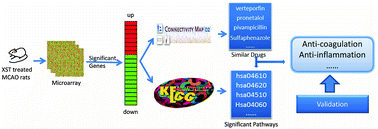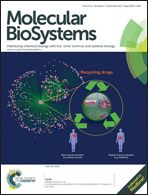Dissecting Xuesaitong's mechanisms on preventing stroke based on the microarray and connectivity map†
Abstract
Elucidating action mechanisms of Chinese medicines has remained a challenging task due to the chemical and biological complexity that needs to be resolved. In this study we applied a gene expression data and connectivity map (CMAP) based approach to study action mechanisms of a Chinese medicine Xuesaitong injection (XST) on preventing cerebral ischemia–reperfusion injury. XST is a standardized patent Chinese medicine of Panax notoginseng roots and it has long been used for the effective prevention and treatment of stroke in China. However, more research is needed to understand the mechanisms underlying its effects against ischemic stroke. We first evaluated the effect of XST against ischemic stroke in an ischemia–reperfusion rat animal model and dissected its mechanisms based on gene expression data of injured brain. The results showed that treatment with XST significantly attenuated infarct area and histological damage. Based upon pathway analysis and the CMAP query of microarray data, anti-inflammatory response and anti-platelet coagulation were found as the major mechanisms of XST against stroke, which were further validated in vitro and with pharmacological assays of serum. We demonstrated the feasibility of applying the combination of the microarray with the CMAP in identifying mechanisms of Chinese medicine.


 Please wait while we load your content...
Please wait while we load your content...